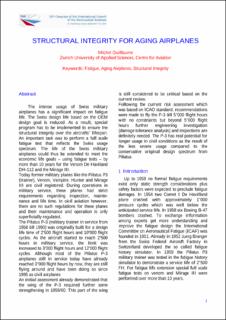Please use this identifier to cite or link to this item:
https://doi.org/10.21256/zhaw-3916Full metadata record
| DC Field | Value | Language |
|---|---|---|
| dc.contributor.author | Guillaume, Michel | - |
| dc.date.accessioned | 2018-08-02T08:20:16Z | - |
| dc.date.available | 2018-08-02T08:20:16Z | - |
| dc.date.issued | 2014 | - |
| dc.identifier.isbn | 978-3-932182-80-8 | de_CH |
| dc.identifier.uri | http://www.icas.org/ICAS_ARCHIVE/ICAS2014/data/papers/2014_0414_paper.pdf | de_CH |
| dc.identifier.uri | https://digitalcollection.zhaw.ch/handle/11475/8771 | - |
| dc.description.abstract | The intense usage of Swiss military airplanes has a significant impact on fatigue life. The Swiss design life based on the OEM design goal is reduced. As a result, special program has to be implemented to ensure the structural integrity over the aircrafts’ lifespan. An important task was to perform a full scale fatigue test that reflects the Swiss usage spectrum. The life of the Swiss military airplanes could thus be extended to meet the economic life goals – using fatigue tests – by more than 10 years for the Venom De Haviland DH-112 and the Mirage III. Today former military planes like the Pilatus P3 (trainer), Venom, Vampire, Hunter and Mirage III are civil registered. During operations in military service, these planes had strict requirements regarding inspection, maintenance and life time. In civil aviation however, there are no such regulations for these planes and their maintenance and operation is only superficially regulated. The Pilatus P-3 (military trainer in service from 1958 till 1990) was originally built for a design life time of 2'500 flight hours and 10'000 flight cycles. As the aircraft started to reach 2'500 hours in military service, the limit was increased to 3'000 flight hours and 12'000 flight cycles. Although most of the Pilatus P-3 airplanes still in service today have already reached 3’000 flight hours by now, they are still flying around and have been doing so since 1995 as civil airplanes. An initial assessment already demonstrated that the wing of the P-3 required further some strengthening in 1959/60. This part of the wing is still considered to be critical based on the current review. Following the current risk assessment which was based on ICAO standard, recommendations were made to fly the P-3 till 5’000 flight hours with no constraints but beyond 5’000 flight hours further engineering investigation (damage tolerance analysis) and inspections are definitely needed. The P-3 has real potential for longer usage in civil conditions as the result of the less severe usage compared to the conservative original design spectrum from Pilatus. | de_CH |
| dc.language.iso | en | de_CH |
| dc.publisher | International Council of the Aeronautical Sciences | de_CH |
| dc.rights | Licence according to publishing contract | de_CH |
| dc.subject | Fatigue | de_CH |
| dc.subject | Aging airplane | de_CH |
| dc.subject | Structural integrity | de_CH |
| dc.subject.ddc | 620: Ingenieurwesen | de_CH |
| dc.title | Structural integrity for aging airplanes | de_CH |
| dc.type | Konferenz: Paper | de_CH |
| dcterms.type | Text | de_CH |
| zhaw.departement | School of Engineering | de_CH |
| zhaw.organisationalunit | Zentrum für Aviatik (ZAV) | de_CH |
| zhaw.publisher.place | Bonn | de_CH |
| dc.identifier.doi | 10.21256/zhaw-3916 | - |
| zhaw.conference.details | 29th Congress of the International Council of the Aeronautical Sciences (ICAS), St. Petersburg, Russia, 7-12 September 2014 | de_CH |
| zhaw.funding.eu | No | de_CH |
| zhaw.originated.zhaw | Yes | de_CH |
| zhaw.publication.status | publishedVersion | de_CH |
| zhaw.publication.review | Peer review (Publikation) | de_CH |
| zhaw.title.proceedings | Proceedings / 29th Congress of the International Council of the Aeronautical Sciences : St. Petersburg, Russia, September 7 - 12, 2014 | de_CH |
| Appears in collections: | Publikationen School of Engineering | |
Files in This Item:
| File | Description | Size | Format | |
|---|---|---|---|---|
| 2014_Guillaume_Structural_integrity_for_aging_airplanes_0414_paper.pdf | 902.77 kB | Adobe PDF |  View/Open |
Show simple item record
Guillaume, M. (2014). Structural integrity for aging airplanes. Proceedings / 29th Congress of the International Council of the Aeronautical Sciences : St. Petersburg, Russia, September 7 - 12, 2014. https://doi.org/10.21256/zhaw-3916
Guillaume, M. (2014) ‘Structural integrity for aging airplanes’, in Proceedings / 29th Congress of the International Council of the Aeronautical Sciences : St. Petersburg, Russia, September 7 - 12, 2014. Bonn: International Council of the Aeronautical Sciences. Available at: https://doi.org/10.21256/zhaw-3916.
M. Guillaume, “Structural integrity for aging airplanes,” in Proceedings / 29th Congress of the International Council of the Aeronautical Sciences : St. Petersburg, Russia, September 7 - 12, 2014, 2014. doi: 10.21256/zhaw-3916.
GUILLAUME, Michel, 2014. Structural integrity for aging airplanes. In: Proceedings / 29th Congress of the International Council of the Aeronautical Sciences : St. Petersburg, Russia, September 7 - 12, 2014 [online]. Conference paper. Bonn: International Council of the Aeronautical Sciences. 2014. ISBN 978-3-932182-80-8. Verfügbar unter: http://www.icas.org/ICAS_ARCHIVE/ICAS2014/data/papers/2014_0414_paper.pdf
Guillaume, Michel. 2014. “Structural Integrity for Aging Airplanes.” Conference paper. In Proceedings / 29th Congress of the International Council of the Aeronautical Sciences : St. Petersburg, Russia, September 7 - 12, 2014. Bonn: International Council of the Aeronautical Sciences. https://doi.org/10.21256/zhaw-3916.
Guillaume, Michel. “Structural Integrity for Aging Airplanes.” Proceedings / 29th Congress of the International Council of the Aeronautical Sciences : St. Petersburg, Russia, September 7 - 12, 2014, International Council of the Aeronautical Sciences, 2014, https://doi.org/10.21256/zhaw-3916.
Items in DSpace are protected by copyright, with all rights reserved, unless otherwise indicated.